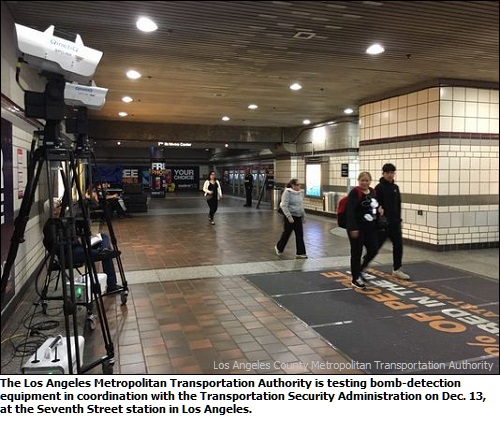
|
|

|
|
| April 25, 2024 |
|
Los Angeles Metro tests bomb-detection equipment in subway 
LOS ANGELES--Federal and Los Angeles security officials are testing equipment that would detect concealed explosives and suicide vests that are at the heart of terror attacks like the one attempted this week in the New York City subway system.
The devices, described in an announcement Wednesday by the Transportation Security Administration and Los Angeles transit officials, look like futuristic cameras on tripods. They're designed to detect improvised explosives by identifying objects that block the natural emissions from a person’s body, according to the TSA. The test, the latest in more than a decade of TSA experiments with the equipment, was announced the same week as a handmade pipe bomb exploded Monday in the New York City subway beneath Times Square. Akayed Ullah, 27, faces five charges, including bombing a public place and providing support for the Islamic State. “Along with industry partners, we are committed to identifying, testing and deploying technology that addresses threats to transportation across the spectrum,” TSA Administrator David Pekoske said in a statement. “We need to innovate and evolve faster than the adversary, and more importantly, deploy technology ahead of the threat-curve.” TSA is testing equipment from several manufacturers. But TSA said the equipment doesn’t emit radiation, like the X-ray machines at an airport checkpoint, and it doesn’t reveal anatomical details of the person screened, as did an earlier generation of full-body scanners used at airport checkpoints. "We're constantly looking on the horizon for technologies that will help improve our security posture here in the Los Angeles County area, so this is one of the technologies that shows some promise to improve security," said Dave Sotero, a Los Angeles County Metropolitan Transportation Authority spokesman. "This particular technology is very non-invasive. You just walk by it." Transit authority workers will operate the equipment, which is provided by TSA to detect either metallic or non-metallic explosives. The worker sits beside the equipment and monitors images on a laptop that alarms for a suspicious object. The test Wednesday and Thursday is at the Seventh Street/Metro Center station in downtown Los Angeles. "It scans for the types of devices that were found in the recent New York pipe bombing," Sotero said. While TSA is best known for airport screening, it is also responsible for protecting ground transportation hubs such as rail and bus stations. Pekoske has called developing technology to deal with evolving threats one of his top priorities. Securing public spaces in airports and heavily traveled transit stations represent the next big challenge for TSA because the transportation hubs are relatively open and can be filled with crowds. In addition to the New York incident, where three people suffered minor injuries, a gunman killed five people in January in the baggage-claim area of the airport in Fort Lauderdale, Fla. Deadly bombings were in public areas of airports in Brussels in March 2016 and in Istanbul in June 2016. Besides the Los Angeles Metro, TSA has been working since 2004 with five passenger rail and transit agencies to test bomb-detection equipment. The agencies include Amtrak, New Jersey Transit, the Washington Metropolitan Area Transit Authority, the San Francisco Bay Area Rapid Transit District and the Los Angeles Sheriff’s Department. Previous tests occurred around Thanksgiving with Amtrak at Washington's Union Station and at the 2014 Super Bowl with New Jersey Transit at the Frank R. Lautenberg Rail Station, according to TSA spokeswoman Lisa Farbstein. (Source: USA Today) Story Date: December 19, 2017
|